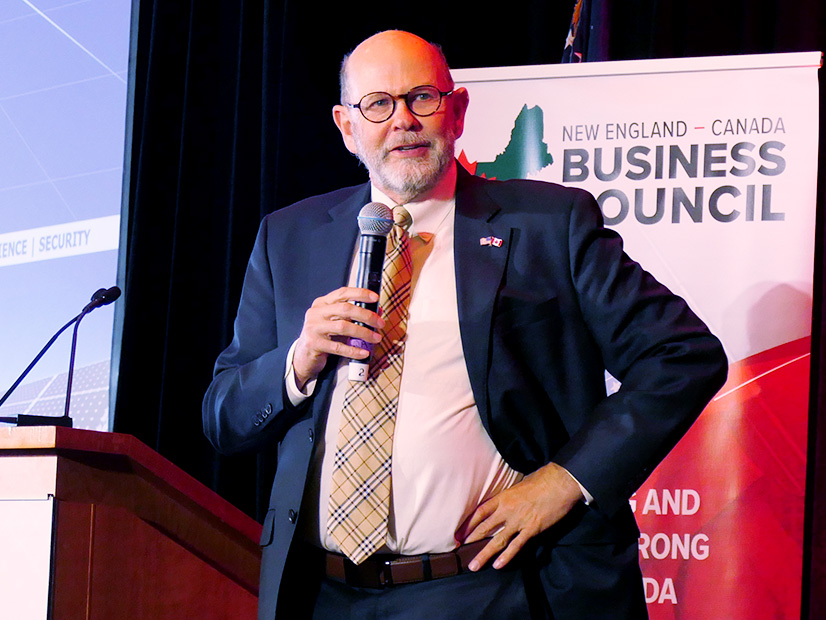BOSTON — Energy leaders from the U.S. and Canada grappled with the challenges of balancing decarbonization and affordability at the New England-Canada Business Council’s (NECBC’s) Executive Energy Conference on Nov. 20-21, discussing how collaboration could lower the cost of the clean energy transition on both sides of the border.
Retail electricity rates in New England are rising faster than nearly all other regions in the U.S., while Hydro-Québec plans to spend billions of dollars to meet demand growth, which it expects to put “upward pressure on electricity rates.”
To juggle major investments preparing for load growth, upgrading aging infrastructure, and incorporating and balancing intermittent renewables, “there needs to be a different way to look at how the investment is funded,” said Nicola Medalova, COO of National Grid’s New England electric business.
Central Maine Power CEO Joseph Purington echoed Medalova’s concerns, saying the increase of public policy costs in electric rates is “not sustainable.”
“We have to start thinking about public policies and the public policy component of the bill,” Purington said. He wondered if some of those costs should be “spread across as a tax instead of as a part of your electric bill.”
The potential loss of federal clean energy funding with the incoming Trump administration likely will add a layer of difficulty for states looking to meet their climate goals without overburdening ratepayers.
Electricity bills can be a regressive funding mechanism to support public policy initiatives: Rising energy costs disproportionately affect low-income individuals, who often are forced to choose between paying energy bills and covering other essential needs like food and health care.
Discount rates can do only so much to mitigate the issue, Medalova said, adding that rate pressures can drive up economy-wide living costs. “Whenever you give a discount, somebody else is picking up the weight of that bill.”
North of the border, political uncertainty in Canada similarly threatens the availability of federal funding, said Monica Gattinger, a political studies professor at the University of Ottawa. Gattinger said public opinion shows climate change has been “dropping like a stone” in the public’s list of priorities, adding that a conservative government “would likely reverse many, if not all, of these policies.”
Competing Priorities
Speakers at the conference discussed a wide range of solutions to help balance the often competing priorities of affordability, reliability and decarbonization.
Medalova and Purington both emphasized the need to unlock retail demand flexibility, a sentiment that was echoed by several other speakers throughout the conference.
ISO-NE CEO Gordon van Welie highlighted the RTO’s finding from its 2050 Transmission Study that a 10% reduction in the 2050 peak load could reduce the required transmission buildout by about a third.
The RTO projects the region’s peak demand to more than double by 2050 and estimates the transmission buildout could cost up to $26 billion. (See ISO-NE Prices Transmission Upgrades Needed by 2050: up to $26B and ISO-NE Analysis Shows Benefits of Shifting OSW Interconnection Points.)
Winston Morton, CEO of Climative, said there is a large amount of remaining potential in energy-efficiency upgrades. He added that these gains have been constrained by the limited scale of state energy-efficiency programs and the gap in capital needed to finance building retrofits.
“We’ve got to attract private capital into the market as quickly as we can,” Morton said, noting that he sees “a positive return on investment for every retrofit.”
Along with transmission needs, load growth also will pose significant resource adequacy challenges for the Northeast.
“We’ve got to figure out how to balance load growth and electrification efforts with reliability,” said NERC CEO Jim Robb, adding that he is “a big advocate of natural gas generation, because it’s so flexible and it can help meet the afternoon ramp.”
Natural gas is the dominant source of electricity generation in New England, and gas-fired generation has been increasing steadily in recent years.
“There is a critical need for gas throughout the year,” said Richard Levitan, president of energy management consultancy Levitan & Associates.
Toby Rice, CEO of EQT, one of the largest U.S. gas producers, pitched attendees on the need to increase natural gas pipeline capacity into the region.
“We’ve hit a wall,” Rice said. “We just need more infrastructure to connect markets.”
Rice chided environmentalists for opposing pipeline projects and argued that additional gas infrastructure would help reduce emissions by displacing coal or oil.
“They should be supporting pipelines because of their concern for climate,” he said.
While replacing coal or oil with natural gas can bring some emissions reductions depending on how much methane is leaked from the system, coal and oil make up only a small fraction of the generation mix in New England, Québec and the Maritime provinces, apart from Nova Scotia.
Increased gas generation has caused greater power system emissions in New England in the past year, and a long-term rise in gas consumption would likely undermine the climate goals set by New England states. Massachusetts state law includes sector-specific emissions limits with increasingly stringent decarbonization targets through 2050.
Rice also argued that increasing LNG export capacity would drive down global emissions, although the climate case for exported LNG is murky. One peer-reviewed study published in October found exported LNG to have a 33% larger carbon footprint than coal over a 20-year period.
Van Welie expressed skepticism that New England would see new pipelines, citing a lack of customers. However, he stressed that existing resources must not be retired faster than new renewables are deployed, especially with anticipated load growth. An ISO-NE study on deep decarbonization published in October found a significant need for clean, dispatchable resources to balance renewables. (See ISO-NE Study Lays Out Challenges of Deep Decarbonization.) The study singled out small modular nuclear reactors (SMRs), synthetic natural gas and multiday energy storage as potential solutions to help meet these needs.
Rudy Cuzzetto, a member of the Legislative Assembly of Ontario, discussed the province’s work to help commercialize SMRs. Ontario likely will have the world’s first full-scale SMR — with a capacity of 300 MW — in operation by 2029, he said.
“The world is looking at Ontario right now,” Cuzzetto said. “We are going to be a powerhouse in Ontario [and] be able to export electricity across the world.”
Québec’s vast hydropower resources also could help to fill the need for dispatchable power, said Serge Abergel, COO for Hydro-Québec Energy Services.
Despite a drop in exports in 2023 from low reservoir levels, Hydro-Québec has indicated that long-term changes to the role that its hydroelectric resources play on the grid could bring savings across the Northeast. (See Québec, New England See Shifting Role for Canadian Hydropower.)
“We are interested in optimizing our grid for our neighbors,” Abergel said. “Let’s have a conversation on regional planning for the long term. Maybe we can save some ratepayer money.”
In theory, increased bilateral transmission capacity between the two countries could provide significant benefits when paired with a surplus of renewables on the New England grid. This would allow New England to export cheap power during periods of excess renewable generation, while enabling Québec to conserve hydropower and send power back to the U.S. during renewable lulls.
Abergel said the company sees “significant savings, especially when you start looking at 2040 and onward.”
Responding to Abergel’s pitch, van Welie said this dynamic would require agreements to provide “a reciprocal benefit” between regions and to ensure Hydro-Québec sells the power back to New England at a reasonable price during periods of low renewable generation.




